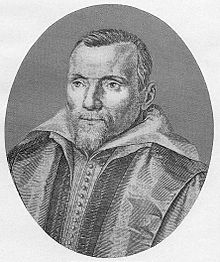- Daniel Heinsius
-
Daniel Heinsius (or Heins) (9 June 1580 – 25 February 1655), one of the most famous scholars of the Dutch Renaissance, was born at Ghent.
Contents
His youth and student years
The troubles of the Spanish war drove Heinsius' parents to settle first at Veere in Zeeland, then to England, next at Ryswick and lastly at Flushing. In 1596, being already remarkable for his attainments, he was sent to the University of Franeker to study law under Henricus Schotanus. In 1598 he settled at Leiden for the nearly sixty remaining years of his life. There he studied under Joseph Scaliger, and there he met Marnix de St Aldegonde, Janus Dousa, Paulus Merula, Hugo Grotius and others; he was soon taken into the society of these celebrated men as their equal.
Professor at Leiden University
His proficiency in the classical languages won the praise of all the best scholars of Europe, and offers were made to him, but in vain, to accept honourable positions outside Holland. He soon rose in dignity at the University of Leiden. In 1602 he started lecturing, in 1603 he was appointed professor of poetics, in 1605 professor of Greek, and at the death of Merula in 1607 he succeeded that illustrious scholar as the 4th librarian of Leiden University Library. As a classical scholar Heinsius edited many Latin and Greek classical as well as patristic authors, amongst others: Hesiod (1603), Theocritus, Bion and Moschus (1603), Aristotle’s Ars poetica (1610), Clement of Alexandria (1616) and Terentius (1618). He brought out the Epistles of Joseph Scaliger in 1627.
Especially influential was his treatise De tragica constitutione (‘How to make a tragedy’, 1611). It was a personal and easily accessible version of what Aristotle had written on tragedy in his Poetics. A revised edition appeared in 1643 with a slightly different title: De constitutione tragoediae.
In 1609 he printed a first edition of his Latin orations. Ever more voluminous new editions appeared until the final edition of 1642 which comprised 35 orations. The collection ended with the ironical Laus pediculi ('In praise of the louse'), which was translated in English by James Guitard in 1634.
Latin poetry
Heinsius first drew attention to himself as a Latin poet with his Senecan tragedy Auriacus, sive libertas saucia (‘William of Orange, or Freedom Wounded’). In 1607/08 he wrote another tragedy, Herodes infanticida (‘The Massacre of the Innocents’), which was published only in 1632. He was, however, especially prolific in writing elegies, of which a large part was dedicated to his love for a girl called Rossa. A first collection appeared in 1603. Ever larger and revised collections of his Poemata, also containing other genres, saw the light regularly.
Dutch poetry
In 1601 he published, under the pseudonym of Theocritus à Ganda (‘Theocritus from Ghent’), Quaeris quid sit Amor...? (‘Do you ask what love is?’), the first emblem book in Dutch. It was re-edited in 1606/07 with the title Emblemata amatoria (‘Love emblems’). A second emblem book, Spiegel vande doorluchtige vrouwen ( ‘Mirror of illustrious women’), was published in 1606. Heinsius also experimented in Dutch poetry after classical models. His efforts were collected by his friend Petrus Scriverius and published as Nederduytsche poemata (‘Dutch poems’) in 1616. They were greatly admired by Martin Opitz, who, in translating the poetry of Heinsius, introduced the German public to the use of the rhyming alexandrine.
His later years
In 1617 he married Ermgard Rutgers, sister of Janus Rutgersius (alias of Mr. Johan Rutgers 1589-1625) one of Scaliger's favorite pupils. They had two children: Nicolas (1620), who was to become a famous Latin poet and book collector, and Elizabeth (1623). At the Synod of Dort (1618-1619) Heinsius was secretary on behalf of the States-General. Afterwards he paid more attention to theology and worked on the text of the Greek New Testament for Elzeviers edition (1624, 1633). In these years he also wrote a large didactic poem, De contemptu mortis (‘On the contempt of death’, 1621), which has a Christian-Stoical content. His wife died in 1633, and Heinsius got into a conflict with Claudius Salmasius, who was appointed as his colleague in 1631. He became more and more lonely and embittered. He stopped lecturing in 1647. He died in 1655 and was buried in Leiden.
He collected some Greek manuscripts, e.g. codex 155.
References
- On Plot in Tragedy, by Daniel Heinsius. Translated by Paul R. Sellin and John J. McManmon, With Introduction and Notes by Paul R. Sellin, Northridge, California 1971 [A translation of De tragoediae constitutione]
- Becker-Cantarino, Baerbel, Daniel Heinsius, Boston 1978
- Bornemann, Ulrich, Anlehnung und Abgrenzung. Untersuchungen zur Rezeption der niederländischen Literatur in der deutschen Dichtungsreform des siebzehnten Jahrhunderts, Assen 1976
- Meter, J.H., The literary theories of Daniel Heinsius. A study of the development and background of his views on literary theory and criticism during the period from 1602 to 1612, Assen 1984
- Sellin, Paul R., Daniel Heinsius and Stuart Engeland, with a Short-Title Checklist of the Works of Daniel Heinsius, Leiden-London 1968
- Jonge, Daniel Heinsius and the Textus Receptus of the New Testament (Leiden, 1971).
- Jonge, The manuscripts Evangeliorum Antiquissimus of Daniel Heinsius, New Test. Stud. 21, pp. 286-294.
 This article incorporates text from a publication now in the public domain: Chisholm, Hugh, ed (1911). Encyclopædia Britannica (11th ed.). Cambridge University Press.
This article incorporates text from a publication now in the public domain: Chisholm, Hugh, ed (1911). Encyclopædia Britannica (11th ed.). Cambridge University Press.
Categories:- 1580 births
- 1655 deaths
- 17th-century Latin-language writers
- Burials at Pieterskerk, Leiden
- Dutch classical scholars
- Dutch people of Belgian descent
- Dutch poets
- Dutch librarians
- Leiden University alumni
- Leiden University faculty
- People from Ghent
- People from Leiden
- Post-imperial Latin poets
- Participants in the Synod of Dort
- Dutch Golden Age writers
- Dutch humanists
Wikimedia Foundation. 2010.

